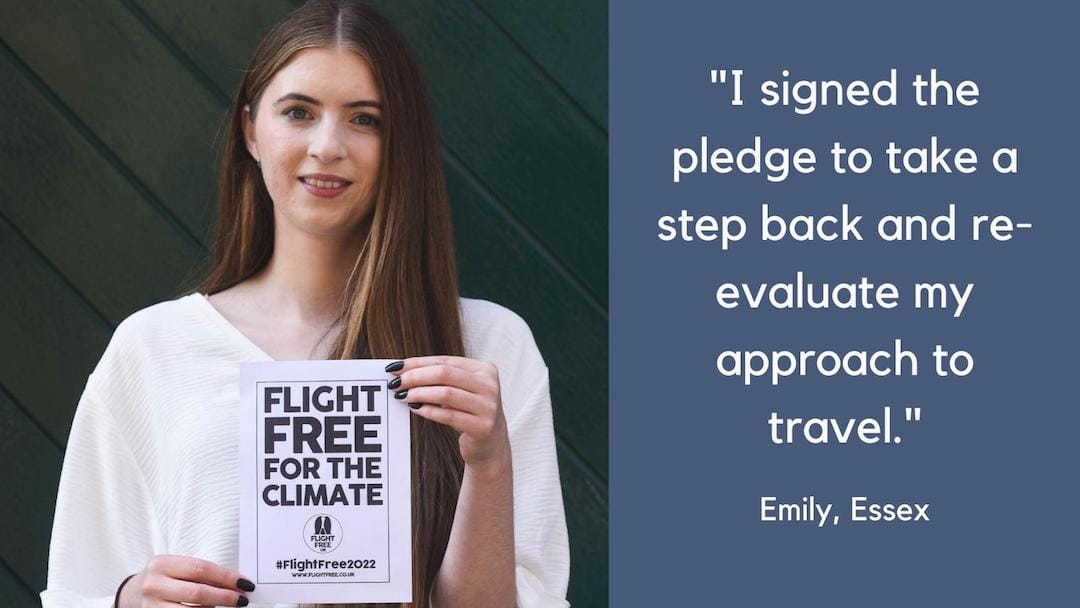It has a certain ring to it, doesn’t it? Jet Zero.
You can almost picture the strategy meeting: “How can we reduce our emissions from jet planes to reach net zero? Hang on, net rhymes with jet! Net zero, Jet Zero! It’s brilliant!”
It’s a great name but that might be where the greatness stops. Underneath all the shiny optimism is a lot of guesswork and some grand statements that do anything but suggest the one thing that might actually make a difference: to look at our lifestyles and change the way we live.
The government's Jet Zero plan boldly speaks of the UK “leading the way” in finding the solutions to climate change. Yet it begins with a telling statement: “Our ambition is to decarbonise aviation in a way that preserves the benefits of air travel…”
It’s clear that this is a policy based on growth. ‘Preserving the benefits' means continuing the upward trajectory that aviation has followed for the last 30 years. The government boasts of working with the Climate Change Committee (CCC), yet there is no mention of its recommendation that demand management will have to play a key role. Instead it’s assumed that other sectors will decarbonise so that aviation doesn’t have to.
So how will we magically reduce emissions with continued growth?
1. SAFs
A lot of faith is placed in SAFs, or sustainable aviation fuels. These typically come from biofuels or waste oil, and have a lower CO2 output than kerosene – sounds like a great idea. But the vast majority of biofuels currently in use come from first generation, food-based biofuel – a leading driver of deforestation. Second-hand oil, such as used cooking oil, is a better solution – but nearly all of this is currently used in the road fleet. We can decarbonise road transport, or we can decarbonise air travel, but we can’t do both.
In the end, the numbers speak for themselves. In early 2021, KLM flew the first SAF-fuelled long haul flight from Paris to Montreal. Around 20 tonnes of CO2 was saved – but the mix of SAF to kerosene was just 16%. That is still 84% kerosene, and over 100 tonnes CO2 produced in emissions. Optimistic forecasts say that we will be using just 5.5% SAFs by 2030. Pessimistic forecasts offer less than 2%.
2. Efficiency gains
Planes are a lot more fuel efficient now than they used to be. Lighter materials and more efficient engines mean that since 1990, per passenger emissions are on average 22% lower than they used to be. With continued efficiency savings, by 2050 we could be looking at a whopping 36% lower emissions.
Yet demand is forecast to increase by 70% in that time. Something doesn't add up here. In 1990 around 90 million passengers passed through UK airports. In 2000 it was 181 million, and 247 million in 2019. The forecast is for 410 million passengers by 2050. Any efficiency gains will be completely undone by rising passenger numbers.
3. New technology
Picture the scene: solar planes connecting our Highlands and Islands; green hydrogen powering our European holidays; airships delivering goods direct to your door. These are not impossible (except perhaps for the airships), but they are not here now, and they won’t be here til at least 2035. Even then, it will take many decades for them to be used on a commercial basis across the board. Faced with climate emergency, we don’t have that long to wait.
It’s good to innovate, and while electric planes sound promising, they’re not without their environmental footprint. Batteries are resource-heavy, physically heavy, and unless powered by 100% renewables, carbon-heavy. It might help us hop around Europe, but electric flight will never be an option for long-haul travel – and anyway, we already have an energy-efficient, electricity-powered form of transport to take us around Europe: the train.
4. Offsetting
And here we finally see the reality of the scheme. Efficiency, SAF, new tech – all that is a nice idea, but it won’t reduce emissions by enough, or reduce them quickly enough. Offsetting is the government’s get-out-of-jail free card. Regardless of how much we can or can't reduce emissions, we can just offset it and still call it net zero.
The key to this whole thing is the focus on ‘net’ zero. It means that we can keep on increasing our emissions as long as we just plant a few trees. It means we can pay for someone else not to produce those emissions instead, and still call it progress. It means we are going to spend millions creating technology that will capture and store carbon, even though we already have a really, really good way of storing carbon – they’re called fossil fuels, and they do a much better job of storing carbon when they are left in the ground.
Offsetting is flawed in so many ways, not just because 85% of schemes are shown to be ineffective, not just because it’s simply not fair to lump our emissions onto someone else to deal with, but because it leads us to believe our emissions don’t count, and that we can continue our polluting behaviour.
Most dangerously, offsets make us believe we can reach net zero if we just pay for it. There is not enough land space on this planet to plant enough trees to compensate for our carbon-hungry lifestyles. Net zero is not zero.
5. Demand reduction
There’s little surprise, in the end, that the government’s Jet Zero plans don’t mention demand reduction at all, despite expert advice from the CCC and popular pressure from campaign groups. It’s a government that wants to have it all. Emissions reduction and endless growth. Climate action and business-as-usual. Cake and eat it.
The reality is that we are facing climate breakdown right now. Not in 30 years’ time. People will lose their lives, and indeed already are, because of the climate crisis. It’s an emergency, and we need an emergency response, not a shiny plan that gives big promises but essentially allows us to carry on as normal.
It will be a vote-winner, sure. Telling people to change how they live is never going to be a popular policy. But the reality of the climate crisis is that we will have to change everything about the way we live – either now, through choice and good policy, or later, through force, when we don't have any choice left.
Perhaps we can turn Jet Zero on its head, to give us Zero Jet. It's a fallacy that we can get where we need to be through technology, innovation and offsetting alone.
The most reliable way to reduce our emissions from aviation has always been the most simple one: fly less.
The government ran a consultation on its Jet Zero plans in 2021. Here is our response, with help from GALBA.
1) Do you agree or disagree that UK domestic aviation should be net zero by 2040? How do you propose this could be implemented?
Agree. There are many ways in which this could be achieved: stop airport expansion; cut flight routes where a viable alternative exists (for example a direct rail route); maintain APD; tax aviation fuel. All of these measures will reduce demand, which is a very effective way of reducing emissions.
2) Do you agree or disagree with the range of illustrative scenarios that we have set out as possible trajectories to net zero in 2050? Are there any alternative evidence-based scenarios we should be considering?
Disagree. It is unrealistic that technology and fuel efficiency developments can make flying net zero on their own. The advice of the Climate Change Committee is to manage demand in order to control aviation emissions in the next 10 years.
3) Do you agree or disagree that we should set a CO2 emissions reduction trajectory to 2050?
Agree. But the measures proposed to achieve that reduction must be realistic, evidence based and reliable. As advised by the IPCC, we must make actual emissions reductions by 2030, whereas Jet Zero proposes an increase. The high level of uncertainty attached to all of Jet Zero’s technical solutions (which is accepted in Jet Zero itself) means that demand management measures are urgently required in addition to the proposals set out in the draft strategy.
a. Should the trajectory be set on an in‑sector CO2 emissions basis (without offsets and removals) or a net CO2 emissions basis (including offsets and removals)?
This should be set on an in‑sector CO2 emissions basis, without offsets and removals.
b. Do you agree or disagree with the possible trajectories we set out, which have in-sector CO2 emissions of 39 Mt in 2030, and 31 Mt in 2040 and 21 Mt in 2050, or net CO2 emissions of 23-32 Mt in 2030, 12‑19 Mt in 2040 and 0 Mt in 2050?
Disagree. Allowing aviation emissions to increase up to 2030 contradicts the government’s new target of cutting UK emissions by 78% by 2035. There is no guarantee that the proposed measures, using as-yet-undeveloped and untested technology, and relying on increased SAF use, will result in the expected emissions reduction.
4) Do you agree or disagree that we should review progress every five years and adapt our strategy in response to progress?
Agree but it would be better to have a more frequent review.
5) Do you agree or disagree with the overall approach to improve the efficiency of our existing aviation system?
Disagree. The assumption of 2% pa efficiency gains does not tally with the CCC and ICAO estimates of 1.4% pa, and does not take into account growth in demand, which is projected to be 70% by 2050.
6) What more or differently could be done to ensure we maximise efficiency within the current aviation system?
Also take measures to reduce demand, so demand increase does not outweigh efficiency savings.
7) Do you agree or disagree with the overall approach for the development and uptake of SAF in the UK?
Disagree. According to the ICCT, SAF usage is unlikely to reach more than 5% by 2030. Problems include the majority of waste oil already being used by the road sector. In addition, biofuels are a leading driver of deforestation, so their use will not reduce emissions overall, and might even lead to an increase. It's no good reducing emissions in one sector only to increase them elsewhere.
8) What further measures are needed to support the development of a globally competitive UK SAF industry and increase SAF usage?
Tax kerosene to make the development of SAFs more attractive. It is difficult to encourage the production and use of a new fuel when the alternative is so much cheaper.
9) Do you agree or disagree with the overall approach for the development of zero emission flight in the UK?
Disagree. Electric flight will not be viable for anything other than short haul aircraft, even by 2050. Hydrogen technology is still in development, and, according to Airbus, might not be in wide use even by 2050. Not all hydrogen is green, and there is a risk that cheaper blue or grey hydrogen could be used in its place.
10) What further measures are needed to support the transition towards zero emission aviation?
Demand management is an essential part of reaching zero emission aviation. In the best case scenario, we will see electric and hydrogen planes come into commercial use by 2035. Until that time, and until we can scale them up to widespread commercial use, we need to reduce demand in order to reduce emissions.
11) Do you agree or disagree with the overall approach for using carbon markets and greenhouse gas removal methods to drive down CO2 emissions?
Disagree. Offsetting does not ‘drive down’ emissions. The CCC specifically rejected counting CORSIA offsets towards the UK’s 2050 net zero trajectory.
It is incongruous to talk about 'driving down' emissions without also talking about 'driving down' demand.
12) What could be done further or differently to ensure carbon markets and greenhouse gas removal methods are used most effectively?
Make the price for each tonne of CO2e offset credit equivalent to the actual cost of GGR technologies that have been proven to remove emissions from the atmosphere. Properly apply the ‘polluter pays’ principle by the immediate cessation of giving free credits to the aviation industry via the UK ETS.
13) Do you agree or disagree with the overall focus on influencing consumers?
Disagree. The focus is on comparing airlines with each other, rather than with other transport modes. This does not give the consumer an accurate picture of how carbon-heavy their travel is, e.g. there might be 10% emissions reduction by choosing a more efficient airline, but there would be a 90% emissions reduction by choosing a train. It’s tantamount to comparing cigarettes for which one will kill you slowest.
14) What more can the Government do to support consumers to make informed, sustainable aviation travel choices?
Compare emissions from flights to emissions from other transport modes. Tax aviation fuel to level the playing field with other transport modes and switch public subsidies to low carbon, ground transport in order to make the sustainable choice the cheaper choice.
15) What could be done further or differently to ensure we tackle non-CO2 impacts from aviation?
Implement the CCC’s priority recommendation in its Progress Report to Parliament in June 2021: “There should be no net expansion of UK airport capacity unless the sector is on track to sufficiently outperform its net emissions trajectory and can accommodate the additional demand. A demand management framework will need to be developed (by 2022) and be in place by the mid-2020s to annually assess and, if required, control sector GHG emissions and non-CO2.”
Respond to the government’s consultation before 11.59pm on 8th September. Go here to read the consultation and submit your response.




